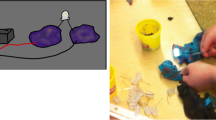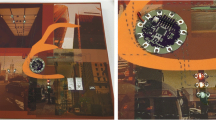Abstract
Motivated by often passingly brief textbook discussions of industrial capacitors, this study examines how students make sense of textbook descriptions to create an industrial rolled-up capacitor. A total of 37 junior-year students at a top high school in Beijing, China, participated in the study. The participants followed their textbook guidance and used the parallel-plate structure as a prototype to make a rolled-up capacitor. To better understand their reasoning, we randomly selected 6 students for interviews: 2 from each of the higher-, middle-, and lower-achieving groups according to their course grades. Each interviewee was asked to recreate a capacitor, draw electric field lines for the (charged) capacitor, and compare its capacitance to that of a parallel-plate structure. Student work showed that the participants took textbook descriptions at face value without considering critical issues such as short circuit. Students’ reasoning of electric field and capacitance revealed that they confused electric field with magnetic field and held classic, nonnormative ideas that liken capacitance to the volume of a body. These results notwithstanding, two middle- and lower-achieving students attempted to make of the rolled-up capacitor and demonstrated a design mindset in their reasoning. Ironically, those traditionally considered as higher-achieving students showed no advantage in this task.




Similar content being viewed by others
References
Brown, J. S., Collins, A., & Duguid, P. (1989). Situated cognition and the culture of learning. Educational Researcher, 18(1), 32–42.
Cole, M. (1996). Cultural psychology: A once and future discipline. Cambridge, MA: Harvard University Press.
Ding, L. (2014). Verification of causal influences of reasoning skills and epistemology on physics conceptual learning. Physical Review Physics Education Research, 10(2), 023101. https://doi.org/10.1103/PhysRevSTPER.10.023101.
Ding, L. (2018). Progression trend of scientific reasoning from elementary school to university: A large-scale cross-grade survey among Chinese students. International Journal of Science and Mathematics Education, 16(8), 1479–1498.
Ding, L. & Reay, N. (2014). Teaching undergraduate introductory physics with an innovative research-based clicker methodology. In D. Sunal, C. Sunal, E. Wright, C. Mason & D. Zollman (Eds.), Research in science education: Research-based undergraduate science teaching (Vol. 6, pp. 305–334). Charlotte, NC: Information Age Publishing.
Finkelstein, N. D. (2005). Learning physics in context: A study of student learning about electricity and magnetism. International Journal of Science Education, 27(10), 1187–1209.
Gette, C. R., & Kryjevskaia, M. (2019). Establishing a relationship between student cognitive reflection skills and performance on physics questions that elicit strong intuitive responses. Physical Review - Physics Education Research, 15(1), 010118.
Gok, T. (2012). The impact of peer instruction on college students’ beliefs about physics and conceptual understanding of electricity and magnetism. International Journal of Science and Mathematics Education, 10(2), 417–436.
Guisasola, J., Almudi, J., Ceberio, M., & Zubimendi, J. (2009). Designing and evaluating research-based instructional sequences for introducing magnetic fields. International Journal of Science and Mathematics Education, 7(4), 699–722.
Guisasola, J., Almudí, J. M., & Zubimendi, J. L. (2004). Difficulties in learning the introductory magnetic field theory in the first years of university. Science Education, 88(3), 443–464. https://doi.org/10.1002/sce.10119.
Guisasola, J., Zubimendi, J., Almudi, J., & Ceberio, M. (2002). The evolution of the concept of capacitance throughout the development of the electric theory and the understanding of its meaning by university students. Science & Education, 11(3), 247–261.
Guisasola, J., Zubimendi, J., Almudi, J., & Ceberio, M. (2007). Using the process of electrical charge of bodies as a tool in the assessment of university students’ learning in electricity. In R. Pinto & D. Couso (Eds.), Contributions from science education research (pp. 225–236). Dordrecht, The Netherlands: Springer.
Guisasola, J., Zubimendi, J., & Zusa, K. (2010). How much have students learned? Research-based teaching on electrical capacitance. Physical Review - Physics Education Research, 6(2), 020102.
Hammer, D. (2000). Student resources for learning introductory physics. American Journal of Physics, 68(S1), S52–S59.
Hammer, D., Elby, A., Scherr, R. E., & Redish, E. F. (2005). Resource, framing, and transfer. In J. P. Mestre (Ed.), Transfer of learning from a modern multidisciplinary perspective (pp. 89–120). Greenwich, England: Information Age Publishing.
Heckler, A. (2011). The ubiquitous patterns of incorrect answers to science questions: The role of automatic bottom-up processes. In J. Mestre & B. Ross (Eds.), Psychology of Learning and Motivation (Vol. 55, pp. 227–267). San Diego, CA: Elsevier Academic Press.
Kapon, S. (2016). Unpacking sensemaking. Science Education, 101(1), 165–198.
Kryjevskaia, M., Stetzer, M., & Grosz, N. (2014). Answer first: Applying the heuristic-analytic theory of reasoning to examine student intuitive thinking in the context of physics. Physical Review - Physics Education Research, 10(2), 020109.
Maries, A., & Singh, C. (2018). Case of two electrostatics problems: Can providing a diagram adversely impact introductory physics students’ problem solving performance? Physical Review - Physics Education Research, 14(1), 010114.
Marton, F. (1986). Phenomenography: A research approach to investigating different understandings of reality. Journal of Thought, 21(3), 28–49.
MOE. (2010). Key curriculum requirements for university physics (and physics laboratory) in science and engineering. Beijing, China: Higher Education Press.
MOE. (2018). High School Physics Curriculum Standards (2017th ed.). Beijing, China: People’s Education Press.
Odden, T. O. B., & Russ, R. (2018a). Defining sensemaking: Bringing clarity to a fragmented theoretical construct. Science Education, 103(1), 187–205.
Odden, T. O. B., & Russ, R. (2018b). Sensemaking epistemic game: A model of student sensemaking processes in introductory physics. Physical Review - Physics Education Research, 14(2), 020122.
Odden, T. O. B., & Russ, R. (2019). Vexing questions that sustain sensemaking. International Journal of Science Education, 41(8), 1052–1070.
Russ, R., & Odden, T. O. B. (2017). Intertwining evidence- and model-based reasoning in physics sensemaking: An example from electrostatics. Physical Review - Physics Education Research, 13(2), 020105.
Sahin, E., & Yagbasan, R. (2012). Determining which introductory physics topics pre-service physics teachers have difficulty understanding and what accounts for these difficulties. European Journal of Physics, 33(2), 315–325.
Sağlam, M., & Millar, R. (2006). Upper high school students’ understanding of electromagnetism. International Journal of Science Education, 28(5), 543–566.
Singh, C. (2008). Assessing student expertise in introductory physics with isomorphic problems. II. Effects of some potential factors on problem solving and transfer. Physical Review - Physics Education Research, 4(1), 010105.
Smith, D., & van Kampen, P. (2013). A qualitative approach to teaching capacitive circuits. American Journal of Physics, 81(5), 389–396.
Thacker, B. A., Ganiel, U., & Boys, D. (1999). Macroscopic phenomena and microscopic processes: Student understanding of transients in direct current electric circuits. American Journal of Physics, 67(S1), S25–S31.
Zhang, P. & Ding, L. (2013). Large-scale survey of Chinese precollege students’ epistemological beliefs about physics: A progression or a regression? Physical Review Physics Education Research, 9(1), 010110. https://doi.org/10.1103/PhysRevSTPER.9.010110.
Acknowledgement
The authors wish to thank Department of Physics at Beijing Normal University and Department of Teaching and Learning at Ohio State University for support on discipline-based physics education research.
Author information
Authors and Affiliations
Corresponding author
Rights and permissions
About this article
Cite this article
Ding, L., Jia, Z. & Zhang, P. From Learning Capacitance to Making Capacitors: the Missing Critical Sensemaking. Int J of Sci and Math Educ 19, 1357–1373 (2021). https://doi.org/10.1007/s10763-020-10112-7
Received:
Accepted:
Published:
Issue Date:
DOI: https://doi.org/10.1007/s10763-020-10112-7




